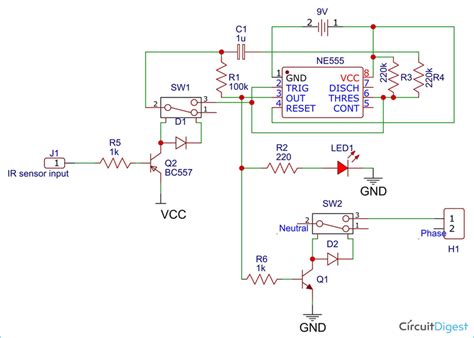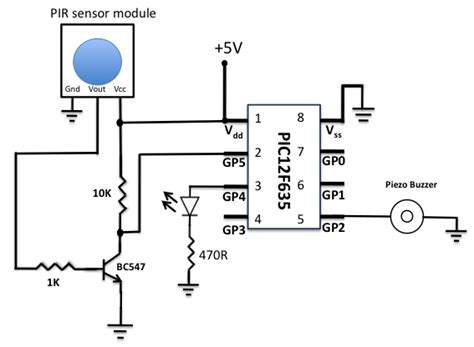How Motion Sensor Circuits Work
The basic principle behind a motion sensor circuit is that it detects a change in some physical quantity associated with motion, such as sound, vibration, heat, or electromagnetic radiation. When an object moves within the sensor’s field of detection, it disturbs one of these quantities which the sensor then converts into an electrical signal.
There are several different types of motion sensors that utilize various methods of detection:
Passive Infrared (PIR) Sensors
PIR Sensors are the most common type of motion sensor. They detect the infrared energy emitted by objects in their field of view. When an object (such as a person) with a different temperature than the background environment moves in front of the sensor, it detects the change in infrared energy and triggers the sensor.
Microwave Motion Sensors
Microwave sensors emit microwave pulses and measure the reflected energy. Moving objects in the sensor’s field cause a Doppler shift in the reflected microwaves which the sensor detects. Microwave sensors can detect motion through obstacles like thin walls and are not affected by heat sources, making them useful in certain applications.
Dual-Technology Motion Sensors
Dual-tech sensors combine two sensing technologies, typically PIR and microwave, into one unit. Both sensors must trip to trigger an alarm, helping reduce false detections. If one sensor is tripped the unit waits to see if the other also detects motion before sounding the alarm.
Ultrasonic Motion Sensors
These sensors emit ultrasonic sound waves and measure the reflected energy, similar to how microwave sensors operate. Moving objects change the frequency of the reflected sound. Ultrasonic Sensors work best in confined spaces and can detect motion behind obstacles, but are sensitive to false alarms from ambient ultrasonic noise.
Motion Sensor Circuit Components
A basic motion sensor circuit consists of the following key components:
| Component | Function |
|---|---|
| Motion sensor | Detects motion using one of the methods described above |
| Microcontroller | Processes the sensor data and controls the circuit operation |
| Resistors and capacitors | Provide necessary voltages and currents for circuit operation and stability |
| Relay or transistor | Switches on a higher-power circuit, like a siren or lights, when triggered |
| Power supply | Provides regulated DC power to the circuit, typically batteries or an AC adapter |
The exact components used will vary depending on the specific application and type of motion sensor employed. Additional components like voltage regulators, resistor networks, and indicator LEDs are also commonly found.

Setting Up a Basic PIR Motion Sensor Circuit
Here’s how to build a simple motion-activated LED circuit using a PIR sensor and an Arduino microcontroller:
Required Components
- PIR motion sensor module
- Arduino Uno or compatible microcontroller board
- LED
- 220Ω resistor
- Breadboard
- Jumper wires
Circuit Diagram
+---------+
| |
GND | | VCC
| PIR |
OUT | |
| |
+---------+
|
| OUT
|
V
+5V --------> Arduino <---- GND
|
| Pin 13
|
+-------+--------+
| |
| [LED]
| |
| +--+
[220Ω] |
| |
| |
----- -----
GND GND
Arduino Sketch
int ledPin = 13; // LED connected to digital pin 13
int pirPin = 2; // PIR sensor connected to digital pin 2
int pirState = LOW; // Store sensor state (HIGH or LOW)
void setup() {
pinMode(ledPin, OUTPUT);
pinMode(pirPin, INPUT);
}
void loop() {
pirState = digitalRead(pirPin);
if (pirState == HIGH) { // If motion detected
digitalWrite(ledPin, HIGH); // Turn LED ON
} else {
digitalWrite(ledPin, LOW); // Turn LED OFF if no motion
}
}
Upload this sketch to the Arduino and the LED should light up whenever the PIR sensor detects motion. Adjust the sensitivity and delay time using the trimpots on the PIR sensor module as needed.
This is just a basic example to illustrate the principles behind a motion sensor circuit. In a real application, you would likely connect the output to something more useful than an LED, like an alarm, camera, or smart home device. The microcontroller code would also be more sophisticated to implement features like adjustable sensitivity, time delays, and communication with other systems.

Applications of Motion Sensor Circuits
Motion sensors find use in a wide array of applications across many different industries and settings. Some common motion sensor applications include:
Security Systems
Motion sensors are a key component in many security systems for homes and businesses. When triggered, they can sound an alarm, activate cameras to record the event, and send alerts to the owner’s smartphone or security company.
Lighting Control
Motion-activated lights are frequently used to automatically illuminate an area when someone enters and shut off soon after they leave. This provides convenience and energy savings compared to regular manual switches.
Automatic Doors
Many businesses and public buildings use motion sensors to operate automatic doors for hands-free entry and exit. The sensor detects an approaching person and triggers a motor to open and close the door.
Occupancy Detection
Smart building systems use motion sensors to detect whether a room is occupied and adjust the HVAC, lighting and other systems to save energy and provide comfort. Similar occupancy detection is used in vehicles to remind drivers to check the back seat for remaining passengers or pets.
Industrial Automation
In industrial settings, motion sensors help automate various processes and improve safety. For example, a sensor might detect when a part arrives at a certain point on an assembly line and trigger a robotic arm to pick it up and perform an operation.
Healthcare
Motion sensors enable many assisted living and health monitoring applications. Wearable sensors can detect falls and send alerts, while room occupancy sensors track activity patterns to spot potential health issues in elderly patients.
The table below summarizes the main application areas and some specific examples of motion sensor usage in each:
| Application Area | Examples |
|---|---|
| Security | Burglar alarms, security cameras, perimeter monitoring |
| Lighting control | Motion-activated lights, smart home lighting |
| Automatic doors | Retail entrances, handicap accessible doors, pet doors |
| Occupancy detection | Smart thermostats, vehicle passenger detection |
| Industrial automation | Assembly lines, robotic controls, safety systems |
| Healthcare | Fall detection, activity monitoring, hand hygiene compliance |
As technology advances, motion sensors are finding even more applications in consumer electronics, smart cities, and beyond. Their ability to detect and respond to human presence and movement make them a versatile tool for automation and interaction.

FAQ
What is the detection range of a typical motion sensor?
The detection range depends on the specific type of sensor and how it is mounted, but generally PIR sensors have a range of about 10-30 feet and a field of view of 90°-180°. Microwave sensors have a longer range up to 100 feet or more. Consult the datasheet of the specific sensor you are using for detailed specifications.
How do I reduce false triggering of my motion sensor?
False triggers can be reduced by adjusting the sensitivity of the sensor, using a sensor with a more focused field of view, and positioning the sensor away from heat sources, moving objects like fans, and reflective surfaces. Dual-technology sensors are also effective at minimizing false alarms by requiring two different sensing methods to trigger.
Can motion sensors detect motion through walls?
PIR sensors cannot see through walls, but microwave sensors can detect motion through thin, non-metal walls and obstacles. Thick walls, metal objects, and stucco surfaces with metal mesh can block microwave sensors.
How do I choose the right type of motion sensor for my application?
Consider factors like the size of the area you need to cover, indoor or outdoor location, desired range and sensitivity, and what specific object or motion you are trying to detect. PIR sensors are good for general indoor applications, while microwave and dual-tech are better for areas with obstacles or outdoor environments.
How long do motion sensors last?
The lifespan of a motion sensor depends on the specific model and how it is used, but generally you can expect them to last at least 5-10 years with regular use. Battery-powered sensors may need more frequent battery changes. Look for sensors from reputable brands with good warranties for best long-term reliability.
In conclusion, motion sensor circuits offer a flexible and powerful way to bring automated sensing and response to a variety of applications. With a basic understanding of how they work and the different types available, you can start integrating these versatile devices into your own electronic projects and systems.

No responses yet